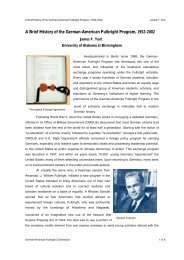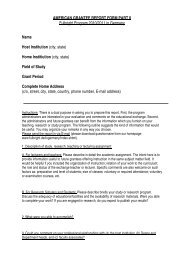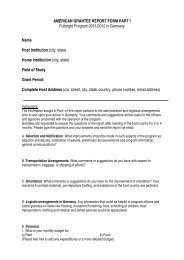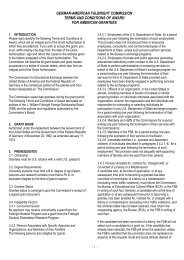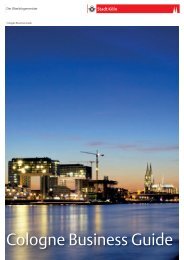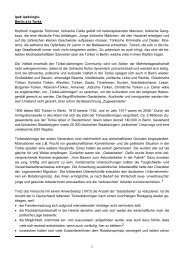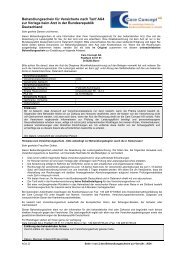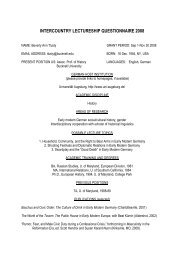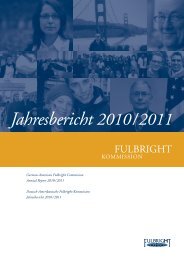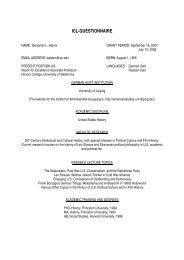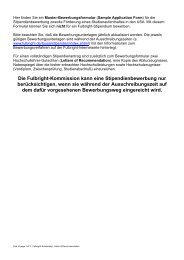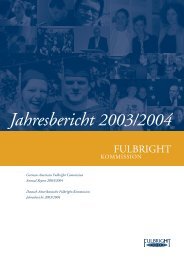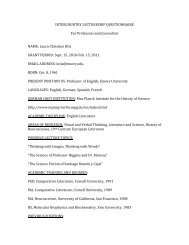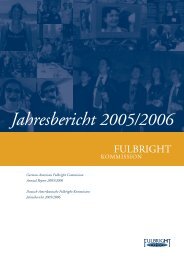The First Class of Fulbrighters - Fulbright-Kommission
The First Class of Fulbrighters - Fulbright-Kommission
The First Class of Fulbrighters - Fulbright-Kommission
You also want an ePaper? Increase the reach of your titles
YUMPU automatically turns print PDFs into web optimized ePapers that Google loves.
Reminiscences on the<br />
<strong>Fulbright</strong> Experience<br />
by Chuck Buntschuh<br />
AS A JUNIOR PHYSICS STUDENT at Massachusetts<br />
Institute <strong>of</strong> Technology (MIT), I was fortunate enough<br />
to spend the summer working in Germany under a program<br />
sponsored by the International Student Association as a technician<br />
in the quality control department <strong>of</strong> the Philips electric<br />
light bulb plant in Aachen. Actually, I didn’t have much to<br />
do—in fact my coworkers teased me when I forgot to turn the<br />
page on the calendar, as that was my job—so I spent a lot <strong>of</strong><br />
time working on my language skills, touring the plant with<br />
one <strong>of</strong> the production engineers, who taught me about the<br />
processes <strong>of</strong> light bulb manufacture, and, best <strong>of</strong> all, getting to<br />
know my colleagues. Becoming immersed in a different culture,<br />
and learning that it wasn’t so terribly different after all,<br />
Those evenings, meals in the dining hall<br />
—with a seemingly infinite supply <strong>of</strong><br />
potatoes—and regular volleyball games<br />
in the backyard provided wonderful<br />
opporttunities to get to know other students.<br />
and the warmth <strong>of</strong> the associations I formed, were such positive<br />
and pr<strong>of</strong>ound experiences that I just had to go back. Not<br />
long after returning to school in the fall, I learned that the<br />
<strong>Fulbright</strong> program was being expanded to Germany. I lost no<br />
time in applying and was thrilled to be accepted.<br />
AS A MEMBER <strong>of</strong> the first <strong>Fulbright</strong> class in 1953 I<br />
matriculated at the Georg-August Universität in Göttingen<br />
to study physics. Early on I found a place at the Max Planck<br />
Institut für Physik in Göttingen where Werner Heisenberg<br />
and Karl Wirtz were co-directors. Pr<strong>of</strong>essor Wirtz, who led<br />
up the experimental physics activities, was my mentor and<br />
encouraged me to undertake a project on measuring some<br />
properties <strong>of</strong> neutron diffusion in graphite, a subject related<br />
to nuclear reactor physics, a field in which the Institut was<br />
heavily engaged.<br />
I was among the fortunate few who applied for and<br />
received a one-year extension to my grant, enabling me to<br />
complete my laboratory work, write a Diplomarbeit, and earn<br />
a Diplomphysiker degree. Even though my later career took<br />
some turns and I moved away from reactor physics, the<br />
immediate result was, after returning to the U.S. and beginning<br />
my two-year tour <strong>of</strong> duty in the Air Force, that I was<br />
assigned as a nuclear engineer in the project <strong>of</strong>fice for the<br />
design and construction <strong>of</strong> a nuclear test reactor. <strong>The</strong> Göttingen<br />
training not only served me well in that position, it was<br />
terrific preparation for research and study on returning to<br />
grad school after the service.<br />
ALTHOUGH I HAD HAD SEVERAL YEARS OF<br />
GERMAN in high school, I had to struggle during the<br />
summer in Aachen to become reasonably pr<strong>of</strong>icient in the<br />
language. One time I went into a shoe shop to purchase<br />
some polish for my white bucks. <strong>The</strong> salesperson asked me,<br />
“Wild- oder Glattleder?” Without my dictionary, I was lost,<br />
and had to return the next day and reply, “Wild!” By the end<br />
<strong>of</strong> the summer, however, I was feeling pretty confident. But<br />
the following year, in Göttingen, in a university setting, I<br />
was virtually blown away by the more sophisticated level <strong>of</strong><br />
the conversation compared to that <strong>of</strong> the factory. So much so<br />
that it took until about Christmas for me to feel really comfortable.<br />
GÖTTINGEN, A LOVELY UNIVERSITY TOWN<br />
<strong>of</strong> about 80,000 people—today it has over a half a million—<br />
was mercifully spared by the Second World War, making it a<br />
delightful place to live and study. (Aachen, on the other<br />
hand, was working diligently to overcome the devastation <strong>of</strong><br />
the Battle <strong>of</strong> the Bulge.) I loved the walk from the Nansen<br />
Haus, where I lived, to the lab, which took me through a<br />
couple <strong>of</strong> parks with inspiring statues <strong>of</strong> famous Göttingen<br />
physicists like Gauß and Weber. And, <strong>of</strong> course, there was<br />
the Konditorei which Jim Turner and Jack Waldrip, the two<br />
other first-year <strong><strong>Fulbright</strong>ers</strong> in Göttingen, and I frequented<br />
enough to claim our favorite spot as our Stammtisch.<br />
<strong>The</strong>re is a large plaza in front <strong>of</strong> the Göttinger Rathaus in<br />
the middle <strong>of</strong> which is a fountain surmounted by a statue <strong>of</strong><br />
a young girl and her goose. It is called the Gänseliesel. It is<br />
supposed to be a tradition that every student has to kiss her<br />
before graduating. I’m not sure how many students actually<br />
observe this tradition, but shortly before my final oral exams,<br />
my friends insisted I had to do it.<br />
IN GÖTTINGEN, I lived in the Fridtj<strong>of</strong> Nansen<br />
Haus, an international student home founded by Rev. Olav<br />
Brennhovd just a year or so earlier. <strong>The</strong> Nansen Haus housed<br />
about 100 students, half German and half from countries all<br />
around the world. Probably my fondest reminiscences <strong>of</strong><br />
Göttingen center around the Nansen Haus and its social life.<br />
<strong>The</strong>re were monthly Hausabende in which we all gathered in<br />
the main hall for a party, <strong>of</strong>ten accompanied by some formal<br />
presentation or activity. Those evenings, meals in the dining<br />
hall—with a seemingly infinite supply <strong>of</strong> potatoes—and regular<br />
impromptu volleyball games in the backyard provided<br />
wonderful opportunities to mix with, and get to know, students<br />
not in one’s smaller circle <strong>of</strong> friends. For the smaller<br />
groups, afternoon tea, trips to the movies, and walks in the<br />
nearby woods were always popular. I shall always cherish<br />
having lived and interacted with such a diverse and fascinating<br />
group <strong>of</strong> people.



